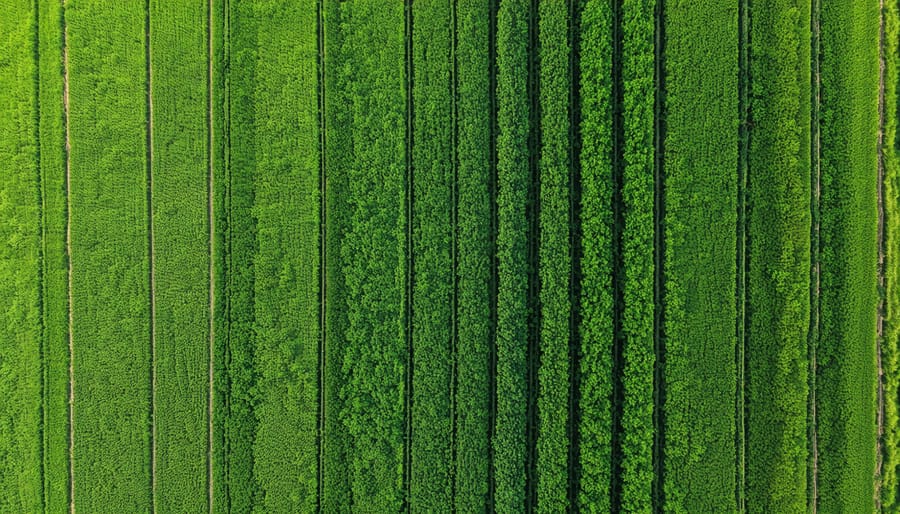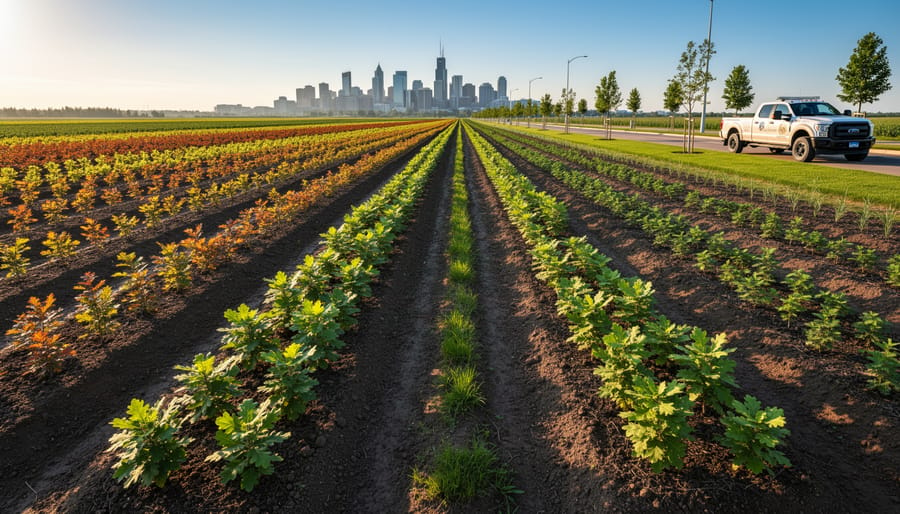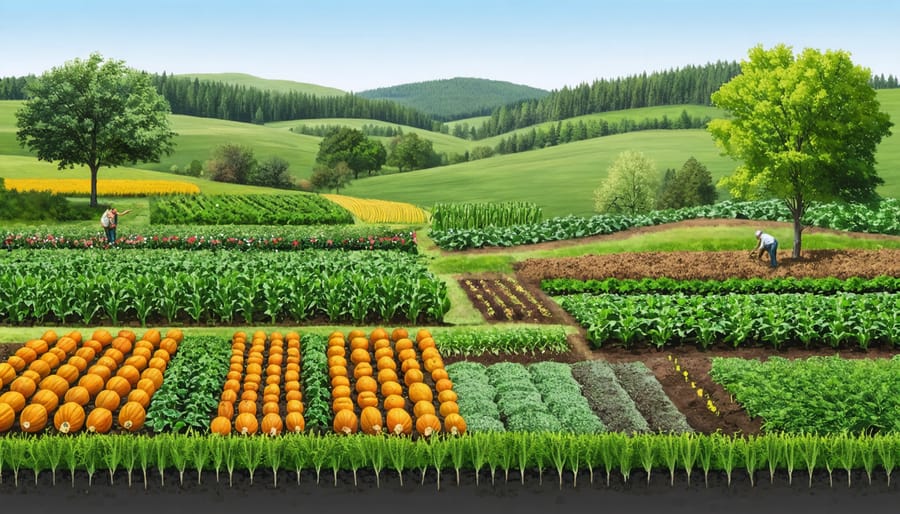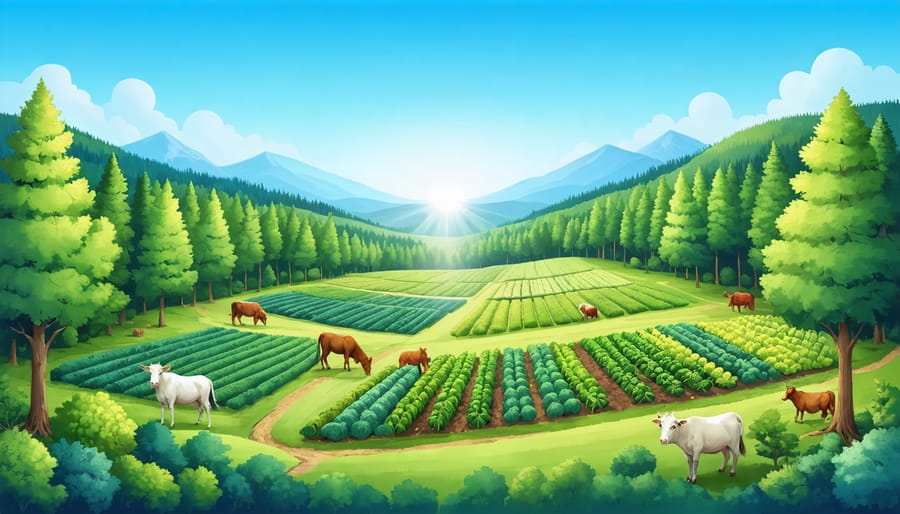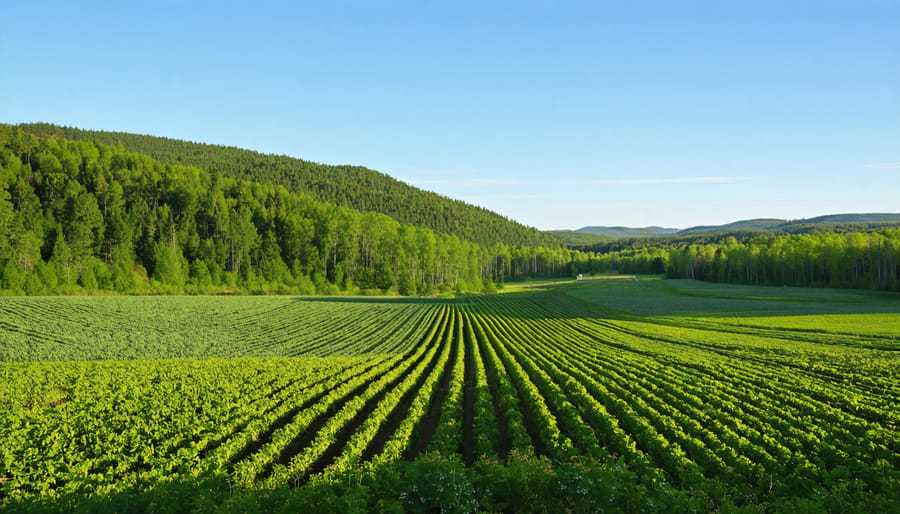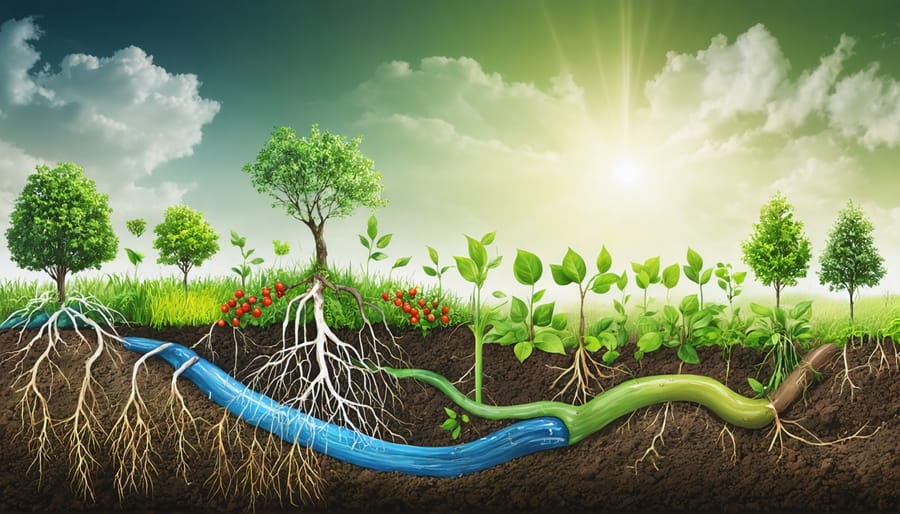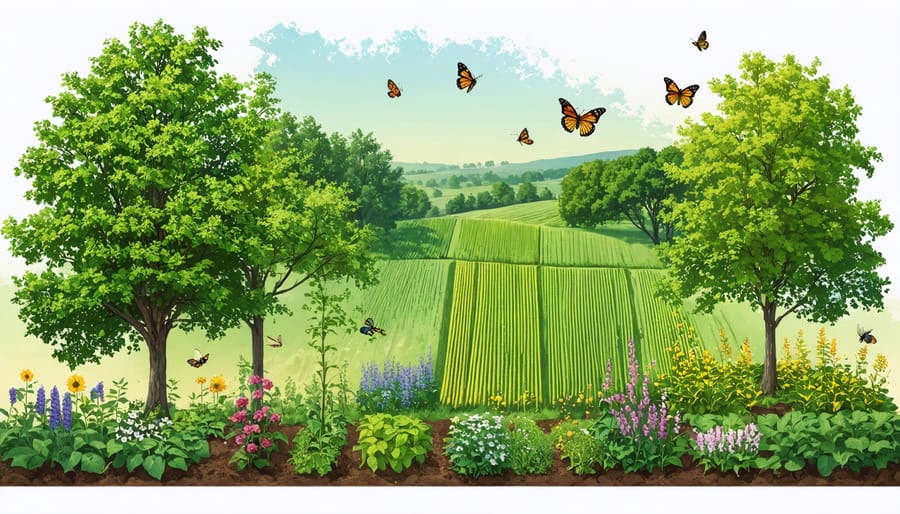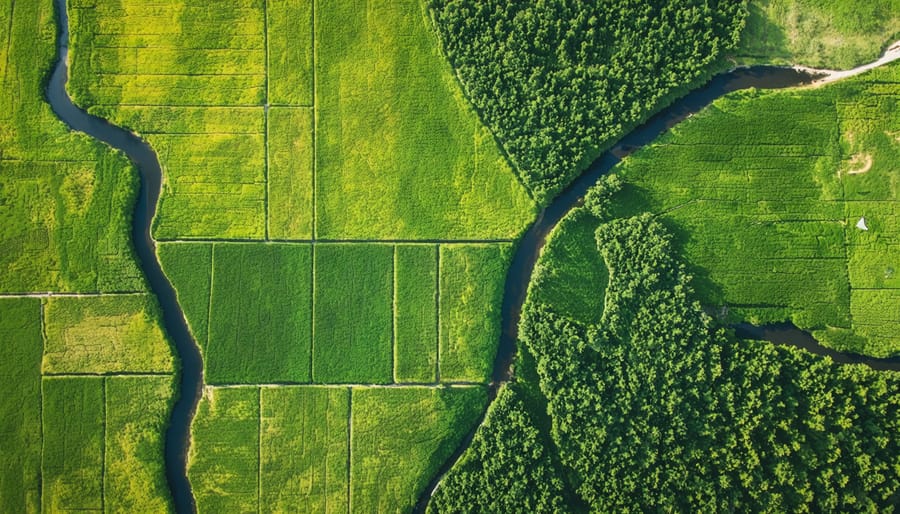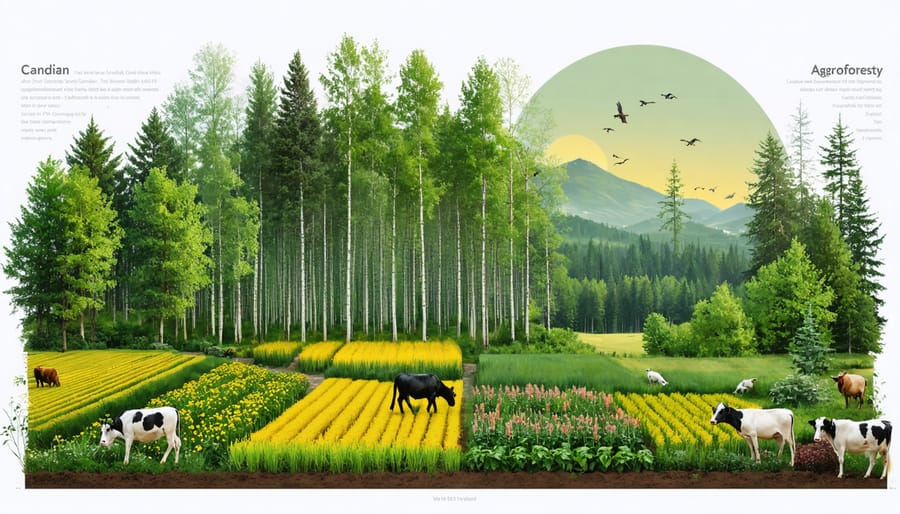Transform agricultural land into a powerful carbon sink through climate-resilient farming practices that benefit both the environment and farm productivity. Canadian farmers are pioneering innovative carbon sequestration techniques that can store up to 2-3 tonnes of carbon per hectare annually while improving soil health and crop yields. By integrating cover crops, reducing tillage, and implementing strategic crop rotations, Alberta’s agricultural sector has the potential to offset 15% of the province’s carbon emissions while generating additional revenue through carbon credit programs.
Modern agricultural carbon sequestration combines traditional farming wisdom with cutting-edge soil science, offering a practical solution to climate change that enhances farm resilience. As global markets increasingly reward sustainable agriculture, Canadian farmers implementing these practices are positioning themselves at the forefront of a transformative agricultural movement that promises both environmental and economic returns. The science is clear: farms that prioritize soil carbon storage consistently demonstrate improved drought resistance, reduced input costs, and enhanced long-term productivity.
The Carbon-Storing Power of Agroforestry
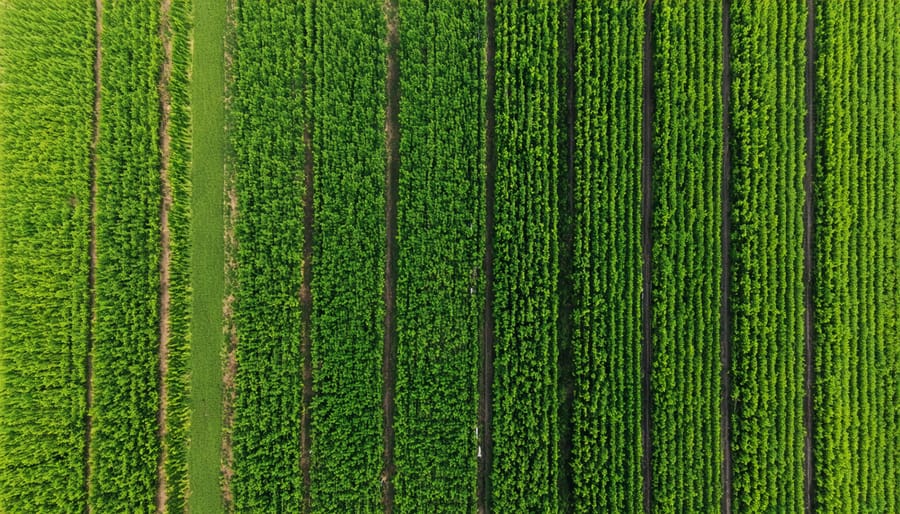
Trees: Your Farm’s Natural Carbon Vacuum
Trees are nature’s most efficient carbon capture technology, and they can work wonders on your farm. A single mature maple or spruce can sequester up to 22 kilograms of carbon dioxide annually while providing valuable benefits to your agricultural operation.
When you incorporate trees into your farmland, whether through shelterbelts, silvopasture, or woodlots, you’re creating natural carbon vaults that store CO2 both above and below ground. The root systems, which can extend several metres deep, lock carbon into the soil while improving its structure and water retention capabilities.
Here in Alberta, strategic tree placement can reduce wind speeds by up to 80%, protecting crops and reducing soil erosion. During our harsh winters, shelterbelts help preserve snow cover, providing crucial spring moisture. In summer, they create microhabitats that support beneficial insects and birds, which naturally control pest populations.
Beyond carbon storage, trees provide additional income opportunities through sustainable wood harvesting, maple syrup production, or fruit and nut cultivation. They’re a long-term investment that pays dividends in both environmental and economic terms.
Soil: The Hidden Carbon Bank
Think of soil as nature’s savings account for carbon – and Alberta farmers are becoming expert bankers in this field. Through strategic agroforestry practices, our agricultural lands can store significant amounts of carbon dioxide from the atmosphere, helping to improve soil health while fighting climate change.
When trees and crops are integrated on farmland, their root systems create a complex underground network that locks carbon into the soil. This process happens naturally, but we can enhance it through practices like shelterbelts, silvopasture, and alley cropping. For example, a study from central Alberta showed that farmland with established shelterbelts stored up to 50% more soil carbon compared to conventional fields.
The best part? This carbon bank pays dividends. Enhanced soil carbon leads to better water retention, reduced erosion, and increased crop yields. Many Alberta farmers report seeing improvements in their soil structure within just 3-5 years of implementing agroforestry practices. By investing in soil carbon today, we’re securing both environmental and economic returns for tomorrow’s agriculture.
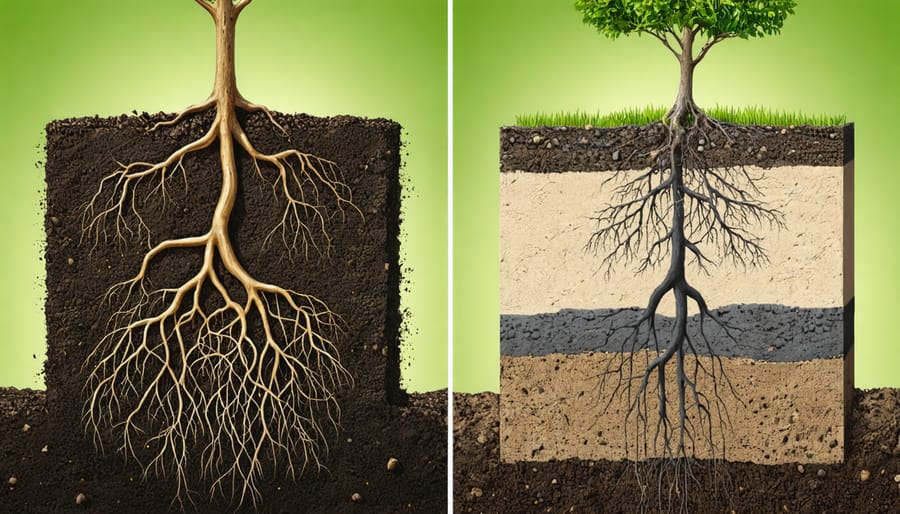
Proven Agroforestry Systems for Alberta
Shelterbelts That Work Double-Duty
The Bowman family farm in Red Deer County stands as a shining example of double-duty shelterbelts in action. In 2015, they planted a mixed-species shelterbelt combining white spruce, green ash, and native shrubs. Not only has this barrier reduced wind erosion by 40% and improved snow retention, but it’s also sequestering an estimated 5-7 tonnes of carbon per kilometre annually.
Over in Lacombe County, Sarah Chen’s innovative approach combines fruit-bearing species with traditional shelterbelt trees. Her design includes saskatoon berries and chokecherries alongside poplar and willow. This arrangement provides additional income through berry harvesting while capturing carbon and protecting her crops.
The Mountain View County Demonstration Project showcases how strategic placement maximizes benefits. Their three-row shelterbelt system, featuring caragana, Manitoba maple, and Colorado spruce, has increased yields in adjacent fields by 15% while storing significant amounts of carbon. Soil tests show organic matter increases of 2% in nearby fields since implementation.
These success stories highlight key principles for effective double-duty shelterbelts:
– Choose diverse species for year-round protection
– Include both fast and slow-growing varieties
– Consider potential secondary products
– Plan for proper spacing and orientation
– Maintain regular maintenance schedules
Local agricultural extension offices can provide specific recommendations for species selection and placement based on your location and goals.
Silvopasture Success Stories
The Davidson family in Red Deer County has been practicing silvopasture for over a decade, integrating spruce and poplar windbreaks with their cattle operation. Since implementing this system in 2012, they’ve noticed improved cattle health during extreme weather events and a 15% increase in soil organic matter.
“The trees provide shelter for our cattle, and we’ve seen better weight gain during winter months,” explains Sarah Davidson. “Plus, the enhanced soil quality has reduced our feed costs significantly.”
In Sturgeon County, the Murray Ranch has transformed 40 hectares into a thriving silvopasture system. By strategically planting hybrid poplars alongside their rotational grazing paddocks, they’ve created diverse pastures that sequester an estimated 5 tonnes of carbon per hectare annually.
Rob Thompson, near Ponoka, combines fruit trees with sheep grazing. His innovative approach includes saskatoon berries and chokecherries, providing additional income streams while maintaining productive grazing land. “It’s about thinking long-term,” Thompson shares. “Our soil tests show increased carbon levels, and we’re seeing more wildlife and beneficial insects than ever before.”
These success stories demonstrate how Alberta farmers are adapting silvopasture to their unique conditions. The Western Silvopasture Network reports that participating farms have seen an average 20% improvement in drought resilience while contributing to carbon sequestration goals.

Alley Cropping: Making Every Acre Count
Alley cropping has gained traction among Alberta farmers as an effective way to maximize land use while boosting carbon sequestration. This system involves planting rows of trees or shrubs between conventional crop areas, creating productive alleys that serve multiple purposes.
Local success stories, like the Morrison Family Farm near Red Deer, demonstrate how combining poplar or willow trees with cereal crops can work in our climate. Their five-year experiment showed a 15% increase in soil organic carbon while maintaining 80% of traditional crop yields in the alleys.
For Alberta farmers considering alley cropping, spacing is crucial. Research from the University of Alberta suggests 15-25 metre intervals between tree rows works best for our Prairie conditions, allowing sufficient sunlight for crops while maximizing wind protection. Native species like green ash and white spruce have shown particular promise, adapting well to our climate while providing valuable shelter belts.
The initial setup costs range from $1,500 to $2,500 per hectare, but government programs like the Canadian Agricultural Partnership can offset up to 70% of these expenses. Many farmers report breaking even within 7-10 years through combined income from crops, carbon credits, and eventual timber harvest.
To get started, consider planting a small test area of 2-3 hectares. Local agricultural extension offices provide free consultations and can connect you with experienced alley croppers in your area.
Getting Started with Carbon-Smart Farming
First Steps: Planning Your System
Before diving into carbon sequestration practices on your farm, it’s essential to develop a well-thought-out plan that considers your unique circumstances. Start by assessing your current land use, soil conditions, and available resources. This initial evaluation will help you understand the costs and challenges of agroforestry and other carbon-capturing methods specific to your operation.
Consider conducting a soil test to establish your baseline carbon levels. Many Alberta agricultural extension offices offer affordable testing services, and the results will help you track your progress over time. Map out your property, identifying areas that could benefit most from carbon sequestration practices, such as marginal lands or erosion-prone zones.
Set realistic goals based on your farm’s size and operational capacity. For example, if you’re managing a 640-hectare farm, you might start by implementing practices on a 40-hectare test plot. This approach allows you to learn and adjust without overwhelming your resources.
Create a timeline that aligns with your farming calendar. Many Alberta farmers find success by planning their carbon sequestration initiatives during the winter months, allowing for implementation during spring seeding or fall harvest periods.
Remember to factor in your budget and available equipment. Many successful carbon farming projects start small and expand gradually. Consider connecting with local farming groups or attending workshops offered by agricultural societies – their practical insights can help you avoid common pitfalls and maximize your success rate.
Take time to research available support programs and grants. The Alberta Carbon Offset System offers opportunities for farmers implementing verified carbon sequestration practices, which could help offset your initial investment.
Available Support and Resources
Alberta farmers have access to numerous support systems and resources to help implement carbon sequestration practices. The Environmental Farm Plan (EFP) program offers free guidance and assessment tools to help you evaluate your farm’s environmental impact and develop sustainable management strategies.
The Canadian Agricultural Partnership (CAP) provides funding opportunities through various streams, including the Farm Technology Program and the Environmental Stewardship and Climate Change Program. These initiatives can cover up to 50% of eligible costs for implementing carbon sequestration practices, with maximum funding amounts ranging from $50,000 to $200,000 per project.
Local Agricultural Service Boards (ASBs) offer technical assistance and can connect you with agricultural fieldmen who provide on-farm consultations. The Alberta Climate Information Service (ACIS) maintains a network of weather stations and provides detailed climate data to help inform your management decisions.
For hands-on learning, the Agriculture Research and Extension Council of Alberta (ARECA) regularly hosts workshops and field days focused on soil health and carbon sequestration techniques. Their demonstration farms showcase successful implementations of various practices across different soil zones.
The Alberta Soil Carbon Quantification Program offers soil testing services and helps farmers track their progress in building soil organic carbon. Additionally, several carbon offset aggregators in Alberta can help you navigate the carbon credit market and monetize your sequestration efforts.
For Indigenous farmers, the Indigenous Agriculture and Food Systems Initiative provides specialized funding and support for implementing traditional and modern sustainable farming practices.
Contact your regional agriculture office or visit the Alberta Agriculture and Forestry website to learn more about these programs and begin your application process.
Economic Benefits and Carbon Credits
Carbon Market Opportunities
Alberta farmers are uniquely positioned to benefit from growing carbon market opportunities. The province’s Carbon Offset System allows agricultural producers to earn carbon credits for implementing practices that reduce greenhouse gas emissions or enhance carbon sequestration. These credits can then be sold to large industrial emitters, creating an additional revenue stream for farm operations.
Current market rates for agricultural carbon credits in Alberta range from $20 to $50 per tonne of CO2 equivalent, with prices expected to rise as Canada moves toward its 2030 climate goals. Farmers can participate through various protocols, including conservation cropping, reduced tillage, and improved grazing management practices.
Several aggregator companies now work directly with Alberta farmers to simplify the process of accessing carbon markets. These organizations handle the verification, documentation, and trading aspects, making it easier for producers to participate. Programs like ALUS Canada and Farmers for Climate Solutions also provide support and resources for farmers entering the carbon market.
To get started, farmers should document their current practices and connect with local agricultural extension offices or carbon credit aggregators. Many successful Alberta farmers are already combining carbon credit revenue with improved soil health practices, creating win-win situations for both their operations and the environment.
Beyond Carbon: Additional Revenue Streams
While carbon credits offer significant revenue potential, agroforestry systems bring additional income streams that enhance farm profitability. The integration of trees and shrubs creates opportunities for diverse crop production, including nuts, fruits, and specialty products like maple syrup or Christmas trees. Many Alberta farmers have found success selling these value-added products directly to local markets.
The multi-layered structure of agroforestry systems also provides water management benefits that can reduce irrigation costs and protect against drought-related losses. This improved water efficiency often translates to higher yields from traditional crops, even during challenging growing seasons.
Additionally, well-designed shelterbelts can reduce winter heating costs for livestock operations by up to 25%. Many farmers report increased pollination services and natural pest control, reducing the need for expensive chemical inputs. Some innovative producers have also developed agritourism opportunities, offering educational tours and workshops that showcase their sustainable farming practices.
These diverse revenue streams help create more resilient farm businesses while contributing to environmental stewardship, making agroforestry an attractive long-term investment for Canadian farmers.
As Alberta’s farming community continues to lead the way in sustainable agriculture, carbon sequestration presents a promising opportunity for both environmental stewardship and farm profitability. By implementing practices like reduced tillage, cover cropping, and strategic crop rotation, you’re not just improving soil health – you’re actively contributing to climate solutions while potentially accessing carbon credit markets.
Remember, every hectare matters. Whether you’re managing a small family farm or a large agricultural operation, your efforts in carbon sequestration make a difference. The tools, resources, and support networks are readily available through local agricultural extension offices and farming cooperatives.
Take the first step today by assessing your current practices and identifying areas where you can enhance carbon capture on your land. Together, we’re building a more resilient and sustainable future for Canadian agriculture, one farm at a time.

